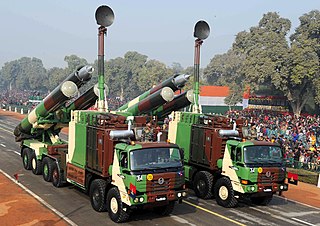
The 10 RAPID Division was a war formed infantry division of the Indian Army during World War II. In four years, the division travelled over 4,000 miles (6,400 km) from Tehran to Trieste, fought three small wars, and fought two great campaigns: the Anglo-Iraqi War, the Invasion of Syria–Lebanon, the Anglo-Soviet invasion of Iran, the North African Campaign, and the Italian Campaign.
The 15th Indian Division was an infantry division of the British Indian Army that saw active service in the First World War. It served in the Mesopotamian Campaign on the Euphrates Front throughout its existence. It did not serve in the Second World War, but was reformed at Dehradun in 1964 as part of the post-independence Indian Army.

The Regiment of Artillery is a combat/fighting arm of the Indian Army, which provides massive firepower during all ground operations of the Indian Army. It is a successor to the Royal Indian Artillery (RIA) of British Indian Army, which itself traces its origins to the formation of Bombay Artillery in 1827.
40 Field Regiment (Asal Uttar), nicknamed the Roaring Forty is part of the Regiment of Artillery of the Indian Army.
23 Field Regiment is part of the Regiment of Artillery of the Indian Army.
1851 Light Regiment is part of the Regiment of Artillery of the Indian Army.
15 Medium Regiment is part of the Regiment of Artillery of the Indian Army.
52 Medium Regiment (Sanjoi Mirpur) is part of the Regiment of Artillery of the Indian Army.
173 Medium Regiment is part of the Regiment of Artillery of the Indian Army.
163 Medium Regiment is part of the Regiment of Artillery of the Indian Army.
151 Air Defence Regiment (Self Propelled) is part of the Corps of Army Air Defence of the Indian Army. It consists of 1511, 1512 and 1513 air defence batteries.
81 Medium Regiment is part of the Regiment of Artillery of the Indian Army.
286 Medium Regiment is part of the Regiment of Artillery of the Indian Army.

1889 Missile Regiment (Kargil) is a missile equipped regiment, which is part of the Regiment of Artillery of the Indian Army.
220 Field Regiment is part of the Regiment of Artillery of the Indian Army.
51 Medium Regiment is part of the Regiment of Artillery of the Indian Army.
44 Field Regiment is part of the Regiment of Artillery of the Indian Army.
60 Medium Regiment is part of the Regiment of Artillery of the Indian Army.
153 Medium Regiment (Self-Propelled) is part of the Regiment of Artillery of the Indian Army.
278 Medium Regiment is part of the Regiment of Artillery of the Indian Army.


